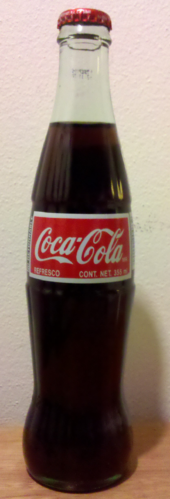Cooking & Baking
Related: About this forumWhat's involved in making your can of Coke
Each can originated in a small town of 4,000 people on the Murray River in Western Australia called Pinjarra. Pinjarra is the site of the world’s largest bauxite mine. Bauxite is surface mined — basically scraped and dug from the top of the ground. The bauxite is crushed and washed with hot sodium hydroxide, which separates it into aluminum hydroxide and waste material called red mud. The aluminum hydroxide is cooled, then heated to over a thousand degrees celsius in a kiln, where it becomes aluminum oxide, or alumina. The alumina is dissolved in a molten substance called cryolite, which is a rare mineral from Greenland, and turned into pure aluminum using electricity in a process called electrolysis. The pure aluminum sinks to the bottom of the molten cryolite, is drained off and placed in a mold. It cools into the shape of a long cylindrical bar. The bar is transported west again, to the Port of Bunbury, and loaded onto a container ship bound for — in the case of Coke for sale in Los Angeles — Long Beach.
The bar is transported to Downey, California, where it is rolled flat in a rolling mill, and turned into aluminum sheets. The sheets are punched into circles and shaped into a cup by a mechanical process called drawing and ironing — this not only makes the can but also thins the aluminum. The transition from flat circle to something that resembles a can takes about a fifth of a second. The outside of the can is decorated using a base layer of urethane acrylate, then up to seven layers of colored acrylic paint and varnish that is cured using ultra violet light, and the inside of the can is painted too — with a complex chemical called a comestible polymeric coating that prevents any of the aluminum getting into the soda. So far, this vast tool chain has only produced an empty, open can with no lid. The next step is to fill it.
Coca-Cola is made from a syrup produced by the Coca-Cola Company of Atlanta. The main ingredient in the formula used in the United States is a type of sugar substitute called high-fructose corn syrup 55, so named because it is 55 per cent fructose or “fruit sugar”, and 42 per cent glucose or “simple sugar” — the same ratio of fructose to glucose as natural honey. HFCS is made by grinding wet corn until it becomes cornstarch. The cornstarch is mixed with an enzyme secreted by a rod-shaped bacterium called Bacillus and an enzyme secreted by a mold called Aspergillus. This process creates the glucose. A third enzyme, also derived from bacteria, is then used to turn some of the glucose into fructose.
The second ingredient, caramel coloring, gives the drink its distinctive dark brown color. There are four types of caramel coloring — Coca Cola uses type E150d, which is made by heating sugars with sulfite and ammonia to create bitter brown liquid. The syrup’s other principal ingredient is phosphoric acid, which adds acidity and is made by diluting burnt phosphorus (made by heating phosphate rock in an arc-furnace) and processing it to remove arsenic.
A much smaller proportion of the syrup is flavors. These include vanilla, which is the fruit of a Mexican orchid that has been dried and cured for around three months; cinnamon, the inner bark of a Sri Lankan tree; coca-leaf which comes from South America and is processed in a unique US government authorized factory in New Jersey to remove its addictive stimulant cocaine; and kola nut, a red nut found on a a tree which grows in the African Rain Forest (this may be the origin of Coca-Cola’s distinctive red logo).
More: https://medium.com/the-ingredients-2/221d449929ef
MiddleFingerMom
(25,163 posts).
.
.
...that one of the results of kidney impairment is a reduced ability/inability to process and
excrete phosphoric acid, leaving it in my body, free to wreak havoc with all sorts of things.
.
My doctor has advised me to avoid all dark sodas as the caramel coloring has a lot of
phosphoric acid. I can drink other sodas with other acids (thank GOODNESS!!!!), just not
any dark ones.
.
I can live with that.
.
.
.
Literally.
.
.
.
Neoma
(10,039 posts)If you hand me soda, I'll only drink 4 sips of it. Can't stand the stuff.
MiddleFingerMom
(25,163 posts).
.
.
I just recently got a home sodamaker, and I've been drinking a lot of
unflavored seltzer (something I've enjoyed for decades) as well as
using my own flavorings (lime juice, vanilla, Crystal Lite, Mio, etc.)
.
.
.
Major Nikon
(36,827 posts)I make homemade root beer or ginger ale every now and then, but mostly it's just plain old seltzer.
MiddleFingerMom
(25,163 posts).
.
.
Club soda has added salts, but seltzer water is simply carbonated water.
.
.
.
Major Nikon
(36,827 posts)pinto
(106,886 posts)Mexican Coke, also called "Coca Cola de Mexico," "Coke de Mexico," or, informally, "MexiCoke," is Coca-Cola that is made and bottled in Mexico in a thick glass bottle. Although intended for consumption in Mexico, Mexican Coke has become popular in the United States because of a flavor that fans call "a lot more natural tasting". The primary difference in flavor between Mexican Coke and the American Coca Cola recipe is that Mexican Coke is sweetened using cane sugar as opposed to high-fructose corn syrup.

http://en.wikipedia.org/wiki/Mexican_Coke
![]()